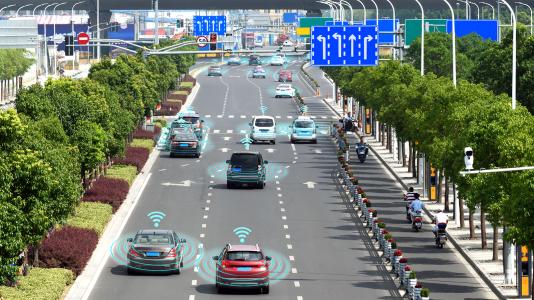
Automotive engineers have evolved powertrain technologies rapidly over the past decades, enabling vehicles to run more efficiently. At the same time, connected and autonomous vehicle (CAV) technologies have emerged — as they mature, they too can offer significant energy savings. Data from sensors, other vehicles and infrastructure can deliver valuable insights into future driving conditions, which automated vehicles can use to minimize their energy consumption.
Whether advanced powertrain and CAV technologies can work together to save energy, however, has largely remained unanswered. Addressing this has the potential to accelerate the efficiency and safety of cars and trucks on the road and offer energy savings to consumers. A team from the U.S. Department of Energy’s Argonne National Laboratory are bringing new algorithms, research tools and experimental processes to bear on this important question.
The multidisciplinary approach
The research team includes experts in modeling and simulation, vehicle control, and experimental testing. They combine their multidisciplinary knowledge with leading-edge laboratory resources to:
- Develop eco-driving and energy-management strategies for advanced powertrain-equipped CAVs, including conventional engine-powered, hybrid and electric-powered vehicles;
- Create research tools enabling them to evaluate and optimize strategies for a wide range of driving conditions, and;
- Develop experimental processes to assess the real-world impacts of these strategies.
Control strategies and research tools
Control algorithms in modern vehicles determine, for example, when to shift gears, when to use battery or engine power in a hybrid, and how to apply regenerative braking to capture electricity back to the battery. With even low levels of automation, these algorithms also have the ability to control vehicle speed. Argonne researchers have been developing control strategies to act on the powertrain energy management and vehicle speed, with the goal of maximizing energy efficiency.
Modeling and simulation are powerful ways to develop and optimize controls but researchers must be able to simulate a wide range of driving conditions and interactions between powertrain and CAV technologies.
“On the control side, we have to consider not just one particular driving scenario but all driving situations, including highway driving as well as driving in traffic,” said Dominik Karbowski, technical manager of intelligent eco-mobility research at Argonne.
Traditional vehicle-level simulations focusing on energy estimation are insufficient as they typically model a single vehicle driving a predefined speed as a function of time. The approach doesn’t work for CAVs, which respond dynamically based on what’s happening in the environment, including surrounding vehicles.
To solve for this, Argonne researchers have developed the Roadrunner framework, which can simulate a wide range of driving and operating conditions, including multiple vehicles with full powertrain models and the interactions between vehicles and their environment. RoadRunner uses powertrain models from Argonne’s popular vehicle energy-consumption simulator Autonomie, but adds new capabilities such as multi-vehicle simulation, road characteristics, vehicle-to-everything (known as V2X) communications and sensors.
“In addition to allowing us to simulate multiple driving situations, the framework also takes into consideration the operational side of the vehicle, such as whether it runs on conventional gas or other fuels, whether it’s a hybrid vehicle, and so on, which is critical to estimating the energy,” Karbowski said.
Experimental testing
Even after subjecting proposed energy management strategies to multiple simulations, researchers must test them in the real world. Argonne researchers have been developing experiments to analyze and validate their models of the energy impact of future mobility technologies.
“You can prototype controls more quickly in a simulated environment but at some point, you’re going to have to tie it into the real world, validating the assumptions that you’ve made within the modeling and simulation environment,” said Argonne principal research engineer Kevin Stutenberg.
Researchers typically test advanced driver assistance systems on road or on track. However, limited control of environmental parameters impacts test-to-test repeatability and undermines efforts to evaluate energy consumption. Argonne researchers have developed a new methodology, known as Vehicle-in-the-loop (VIL), to overcome limitations in accurately assessing CAV energy consumption.
In the VIL system, researchers place an actual vehicle driving on a traditional chassis dynamometer (device for simultaneously measuring the torque and rotational speed of an engine or motor) in a virtual environment. For example, research engineers can override test vehicle’s radar sensor outputs to pretend the car is following another vehicle. This ability to overwrite sensor outputs, as well as electronic control unit commands, allows engineers to characterize a range of state-of-the-art control algorithms.
The VIL methodology is an important capability in the development chain of new mobility technologies. Assessing the benefits and identifying tradeoffs and risks will help all of us realize gains from these new transportation futures.
This work is funded through the Systems and Modeling for Accelerated Research in Transportation (SMART) Mobility Consortium, an initiative of the Vehicle Technologies Office within DOE’s Office of Energy Efficiency & Renewable Energy.